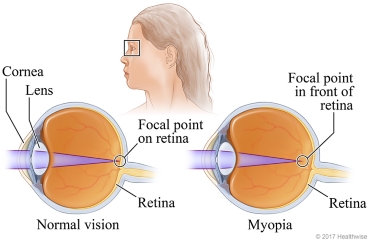Nearsightedness (Myopia) in Children: Care Instructions
Overview

A child who is nearsighted can see things that are up close. But your child has trouble seeing things in the
distance. Faraway objects look blurry and out of focus. It may be hard for your child to see images or words
on a street sign, movie screen, or TV.
Children who are nearsighted may squint or frown or hold books or other objects very close to the face. They
may sit at the front of the classroom or very close to the TV or movie screen. They may not be interested in
sports or other things that need good distance vision.
This vision problem is often caused by a natural change in the shape of the eyeball. The eyeball is oval
(egg-shaped) rather than round. This causes light rays that enter the eye to focus in front of the retina
rather than directly on it.
Eyeglasses or contact lenses can help correct nearsightedness.
Follow-up care is a key part of your child's treatment and safety. Be sure to make and go to all
appointments, and call your doctor if your child is having problems. It's also a good idea to know your
child's test results and keep a list of the medicines your child takes.
How can you care for your child at home?
Reduce eyestrain
-
Make sure that your child wears eyeglasses or contact lenses as prescribed.
-
Provide good light for reading or study. Use a soft background light plus a light on your child's task.
-
Have your child take frequent breaks when they do close work that can be hard on the eyes. Tell your child
to blink often and to close and rest their eyes when they feel tired or dry. Set a 20-minute timer and have
your child look at something 20 feet away for 20 seconds (the "20-20-20" rule).
-
Avoid glare on screens. Place the TV or computer screen where lights do not reflect on the screen. Some
children find it easier to work on a computer in a dimly lit room. You can also try an anti-glare screen or
screen protector.
Keep your child's eyes healthy
-
Make sure your child gets eye exams as often as your doctor recommends.
-
Have your child wear sunglasses to block harmful sunlight. Choose a pair that will screen out ultraviolet
A and B (UVA and UVB) rays.
When should you call for help?
 Watch closely
for changes in your child's health, and be sure to contact your doctor if:
Watch closely
for changes in your child's health, and be sure to contact your doctor if:
Current as of: June 5, 2023
Content Version: 14.0
Care instructions adapted under license by your
healthcare professional. If you have questions about a medical condition or this instruction, always ask
your healthcare professional. Healthwise, Incorporated disclaims any warranty or liability for your use of
this information.